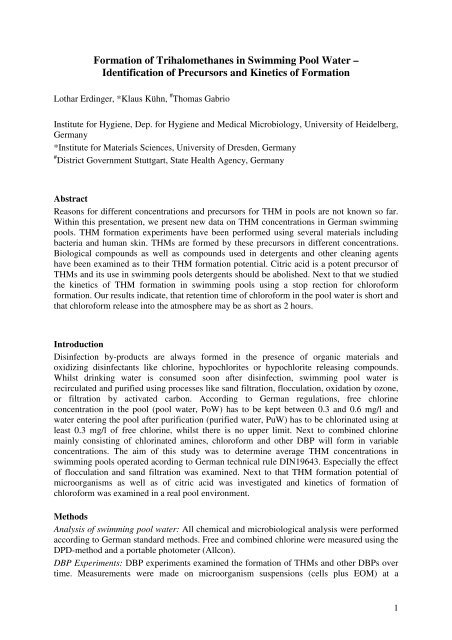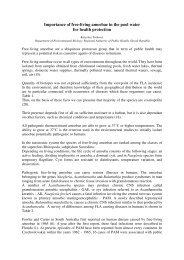Formation of Trihalomethanes in Swimming Pool Water ...
Formation of Trihalomethanes in Swimming Pool Water ...
Formation of Trihalomethanes in Swimming Pool Water ...
You also want an ePaper? Increase the reach of your titles
YUMPU automatically turns print PDFs into web optimized ePapers that Google loves.
Immediately after <strong>in</strong>sertion chlor<strong>of</strong>orm concentration starts to rise while concentration <strong>of</strong> freechlor<strong>in</strong>e decl<strong>in</strong>es. Concentration <strong>of</strong> free chlor<strong>in</strong>e reached 0.13 mg/l after three hours,chlor<strong>of</strong>orm concentration was 7.0 µg/l after this time. A couple <strong>of</strong> additional peaks could beidentified. One <strong>of</strong> these peaks was trichloroacetonitril ris<strong>in</strong>g parallel to chlor<strong>of</strong>orm. Data forthis compound are given as peak area.Chlor<strong>in</strong>ation <strong>of</strong> bacteria yields similar results. Figure 6 displays development <strong>of</strong> free andcomb<strong>in</strong>ed chlor<strong>in</strong>e, as well as chlor<strong>of</strong>orm and trichloracetonitril dur<strong>in</strong>g chlor<strong>in</strong>ation <strong>of</strong>washed cultures <strong>of</strong> Pseudomonas aerug<strong>in</strong>osa dissolved <strong>in</strong> tap water and dis<strong>in</strong>fected withlaboratory grade Na-hypochlorite solution. K<strong>in</strong>etics <strong>of</strong> the reaction is about the same asreaction <strong>of</strong> human sk<strong>in</strong> with chlor<strong>in</strong>e. Figure 7 depicts results <strong>of</strong> a similar experiment us<strong>in</strong>gStaphylococcus aureus as test organisms. Staphylococcus aureus is a gram positivemicroorganism and therefore differs <strong>in</strong> organisation <strong>of</strong> the cell walls.It is known s<strong>in</strong>ce long that some organic compounds like citric acid are precursors <strong>of</strong>chlor<strong>of</strong>orm formation. K<strong>in</strong>etics <strong>of</strong> chlor<strong>of</strong>orm formation by citric acid is shown <strong>in</strong> figure 8.Reaction k<strong>in</strong>etics is first order <strong>in</strong> citric acid. Compared to reaction <strong>of</strong> hypochlorite withmicroorganisms or with the sk<strong>in</strong>, reaction rate is slightly slower.Due to its water solubility and its vapour pressure, chlor<strong>of</strong>orm will escape from the pool waterand can be detected <strong>in</strong> swimm<strong>in</strong>g pool air. K<strong>in</strong>etics <strong>of</strong> chlor<strong>of</strong>orm formation and outgass<strong>in</strong>gfrom pool water is not known up to now. In order to <strong>in</strong>vestigate these basic chemical aspects<strong>of</strong> DBP formation chemistry, decl<strong>in</strong>e <strong>of</strong> chlor<strong>of</strong>orm and formation <strong>of</strong> brom<strong>of</strong>orm wasmeasured after addition <strong>of</strong> KBr to swimm<strong>in</strong>g pool water. Hypochlorite is a stronger oxidantthan hypobromite, therefore chlor<strong>of</strong>orm formation will stop and brom<strong>of</strong>orm will be formed <strong>in</strong>the presence <strong>of</strong> bromide <strong>in</strong> the water.6e+53,00,775e+52,50,66Trichloracetonitril (Peak area)4e+53e+52e+5Free Cl [mg/l]2,01,51,00,5Free ClComb ClChlor<strong>of</strong>ormTrichloracetonitril0,50,40,30,20,1Comb. Cl [mg/l]5432Chlor<strong>of</strong>orm [ug/l]1e+50,00,010-40 -20 0 20 40 60 80 1000Figure 6: Chlor<strong>in</strong>ation <strong>of</strong> Pseudomonas aerug<strong>in</strong>osa. <strong>Formation</strong> <strong>of</strong> comb<strong>in</strong>ed chlor<strong>in</strong>e,chlor<strong>of</strong>orm and trichloracetonitril, decl<strong>in</strong>e <strong>of</strong> free chlor<strong>in</strong>e.We added KBr to swimm<strong>in</strong>g pool water thus stopp<strong>in</strong>g the formation <strong>of</strong> chlor<strong>of</strong>orm nearlyimmediately. The only THM formed after addition <strong>of</strong> sufficient amounts <strong>of</strong> KBr will bebrom<strong>of</strong>orm, and chlor<strong>of</strong>orm will only escape from the water.4
Two series <strong>of</strong> analysis have been performed on two subsequent days. Dur<strong>in</strong>g the first day,chlor<strong>of</strong>orm concentration was monitored from 9 am to 10 pm. First sample was taken 1 hourbefore open<strong>in</strong>g <strong>of</strong> the pool, last sample was taken 1 hour after closure. Dur<strong>in</strong>g the first day,chlor<strong>of</strong>orm concentration <strong>in</strong> the water rises from 8 µg/l to 12 µg/l. The next day, thischlor<strong>of</strong>orm concentration was still present <strong>in</strong> the water. However, chlor<strong>of</strong>orm concentrationdecl<strong>in</strong>es immediately after KBr is added to the water. Half-life <strong>of</strong> chlor<strong>of</strong>om concentration <strong>in</strong>the pool water is app. 2 h.1,8e+63,20,310Trichloracetonitril [Peak Area]1,6e+61,4e+61,2e+61,0e+68,0e+56,0e+54,0e+5Free Cl [mg/L]3,02,82,62,42,22,01,81,6Free ClComb ClChlor<strong>of</strong>ormTrichloracetonitril0,20,1Comb Cl [mg/L]8642Chlor<strong>of</strong>orm [µg/L]2,0e+51,40,00,01,20-60 -30 0 30 60 90 120 150 180 210 240M<strong>in</strong>utesFigure 7: Chlor<strong>in</strong>ation <strong>of</strong> Staphylococcus aureus. <strong>Formation</strong> <strong>of</strong> comb<strong>in</strong>ed chlor<strong>in</strong>e,chlor<strong>of</strong>orm and trichloracetonitril, decl<strong>in</strong>e <strong>of</strong> free chlor<strong>in</strong>e.16141412w/o KBr: CHCl3w KBr: CHCl31210Chlor<strong>of</strong>orm [µg/L]10864CHl3 µg/l8642020 1 2 3 4 5 6M<strong>in</strong>utes008:00:00 12:00:00 16:00:00 20:00:00DaytimeFigure 8: Chlor<strong>in</strong>ation <strong>of</strong> citric acid.<strong>Formation</strong> <strong>of</strong> chlor<strong>of</strong>orm.Figure 9: Decl<strong>in</strong>e <strong>of</strong> CHCl3 concentration <strong>in</strong>swimm<strong>in</strong>g pool water after addition <strong>of</strong> KBr.5
DiscussionIt is well known that chlor<strong>in</strong>ation <strong>of</strong> dr<strong>in</strong>k<strong>in</strong>g waters produces trihalomethanes (THMs) andother chlor<strong>in</strong>ated byproducts. Dr<strong>in</strong>k<strong>in</strong>g water supplies conta<strong>in</strong> sundry organic compounds thatare dist<strong>in</strong>ct to the area; orig<strong>in</strong>ate from natural processes, such as flora and fauna decay; andare collectively called natural organic matter (NOM) (Barret and Krasner 2000; Croué et al1999; Menear and Amy 1996). These naturally occur<strong>in</strong>g organics, such as humic and fulvicmaterials, serve as precursors for Dis<strong>in</strong>fection Byproducts <strong>in</strong> dr<strong>in</strong>k<strong>in</strong>g water (Reckhow et al1990). Cells <strong>of</strong> the human sk<strong>in</strong> as well as bacterial cells and algae cells and their excretedmetabolic products may contribute to the DBP precursor pool <strong>in</strong> swimm<strong>in</strong>g pools, produc<strong>in</strong>gboth THMs and haloacetonitriles upon chlor<strong>in</strong>ation. Whilst there are many papers describ<strong>in</strong>gdetails <strong>of</strong> THM production by chlor<strong>in</strong>ation <strong>of</strong> algae (Plummer 2001) and humic (Reckhow1990) and fulvic acids (Miller and Uden 1983; Oliver 1983)), there is only little <strong>in</strong>formationon THM formation by chlor<strong>in</strong>ation <strong>of</strong> human sk<strong>in</strong> or bacteria.The fate <strong>of</strong> organic nitrogen and carbon <strong>in</strong>troduced <strong>in</strong>to a swimm<strong>in</strong>g pool by users has beenstudied us<strong>in</strong>g a model pool (Judd and Bullock 2003). The authors used a synthetic „BodyFluid Analogen” (BFA) conta<strong>in</strong><strong>in</strong>g organic am<strong>in</strong>o compounds and citric acid. Our<strong>in</strong>vestigations show that chlor<strong>of</strong>orm concentrations <strong>in</strong> swimm<strong>in</strong>g pools can be expla<strong>in</strong>ed byreaction <strong>of</strong> chlor<strong>in</strong>e with human sk<strong>in</strong> as well as by reaction with microorganisms present <strong>in</strong>the water or brought <strong>in</strong> by bathers and additionally by chemical reactions <strong>of</strong> compounds likecitric acid.87Sk<strong>in</strong> Chlor<strong>of</strong>orm [µg/L]65432100 1 2 3 4 5 6 7Pseudomonas aerug<strong>in</strong>osa Chlor<strong>of</strong>orm [µg/L]Figure 10: Comparison <strong>of</strong> k<strong>in</strong>etics <strong>of</strong> sk<strong>in</strong> chlor<strong>in</strong>ation and chlor<strong>in</strong>ation <strong>of</strong> Pseudomonasaerug<strong>in</strong>osaFigure 10 shows the correlation <strong>of</strong> chlor<strong>of</strong>orm k<strong>in</strong>etics <strong>of</strong> a suspension <strong>of</strong> Pseudomonasaerug<strong>in</strong>osa and chlor<strong>in</strong>ation <strong>of</strong> human sk<strong>in</strong>. Results <strong>in</strong>dicate that similar reactions take placealthough the identity <strong>of</strong> the precursors is not known. Reaction rate <strong>of</strong> citric acid is slower.Nevertheless this compound can contribute significantly to THM concentrations <strong>in</strong> swimm<strong>in</strong>gpools because <strong>of</strong> its high concentration <strong>in</strong> ur<strong>in</strong>e. Release <strong>of</strong> organic acids like oxalic acid andcitric acid can be as high as 3 g/day. The formation <strong>of</strong> THM <strong>in</strong> by citric acid can be catalysed6
<strong>in</strong> the presence <strong>of</strong> copper ions <strong>in</strong> the water (Blatchley et al 2003). Additionally, citric acid isfrequently used <strong>in</strong> swimm<strong>in</strong>g pools as a component <strong>of</strong> clean<strong>in</strong>g agents.Rate <strong>of</strong> decrease <strong>of</strong> chlor<strong>of</strong>orm <strong>in</strong> a swimm<strong>in</strong>g pool, were chlor<strong>of</strong>orm formation was stoppedus<strong>in</strong>g a KBr based reaction, <strong>in</strong>dicates that chlor<strong>of</strong>orm formation <strong>in</strong> swimm<strong>in</strong>g pools isbasically a fast process. Half live <strong>of</strong> chlor<strong>of</strong>orm under these conditions was 2 hours whilstwithout addition <strong>of</strong> KBr chlorform concentration was ris<strong>in</strong>g with about 0.5 µg/l*h. However,THM concentrations <strong>in</strong> the pool where these measurements have been made were lowcompared to other pools because <strong>of</strong> awater slide and massage jet outlets <strong>in</strong> the pool.Further <strong>in</strong>vestigations will show which <strong>of</strong> these reactions is the ma<strong>in</strong> contributor tochlor<strong>of</strong>orm formation <strong>in</strong> swimm<strong>in</strong>g pools.LiteratureBarrett, S. E., Krasner, S., Eds. Natural Organic Matter and Dis<strong>in</strong>fection By-Products:Characterization and Control <strong>in</strong> Dr<strong>in</strong>k<strong>in</strong>g <strong>Water</strong>; ACS Symposium Series, Vol. 761;American Chemical Society: Wash<strong>in</strong>gton, DC, 2000.Blatchley ER 3rd, Margetas D, Duggirala R: Copper catalysis <strong>in</strong> chlor<strong>of</strong>orm formation dur<strong>in</strong>gwater chlor<strong>in</strong>ation. <strong>Water</strong> Res. 37 (2003) 4385-4394.Croué, J.-P.; Korsh<strong>in</strong>, G. V.; Benjam<strong>in</strong>, M., Eds. Characterization <strong>of</strong> Natural Organic Matter<strong>in</strong> Dr<strong>in</strong>k<strong>in</strong>g <strong>Water</strong>; American <strong>Water</strong> Works Association: Denver, CO, 1999.Erd<strong>in</strong>ger L, Kühn KP, Kirsch F, Feldhues R, Frobel T, Nohynek B, Gabrio T: Pathways <strong>of</strong>trihalomethane uptake <strong>in</strong> swimm<strong>in</strong>g pools. Int J Hyg Environ Health. 207 (2004) 571-575.Judd SJ, Bullock G: The fate <strong>of</strong> chlor<strong>in</strong>e and organic materials <strong>in</strong> swimm<strong>in</strong>g pools.Chemosphere 51 (2003) 869-879.M<strong>in</strong>ear, R. A., Amy, G. L. Eds. <strong>Water</strong> Dis<strong>in</strong>fection and Natural Organic Matter:Characterization and Control; ACS Symposium Series, Vol. 649; American ChemicalSociety: Wash<strong>in</strong>gton, DC, 1996.Oliver BG: Dihaloacetonitriles <strong>in</strong> dr<strong>in</strong>k<strong>in</strong>g water: algae and fulvic acid as precursors. EnvironSci Technol 17 (1983) 80-83.Plummer JD, Edzwald JK: Effect <strong>of</strong> ozone on algae as precursors for trihalomethane andhaloacetic acid production. Environ Sci Technol 35 (2001) 3661-3668.Reckhow DA, S<strong>in</strong>ger PC, Malcolm RL: Chlor<strong>in</strong>ation <strong>of</strong> humic materials: Byproductformation and chemical <strong>in</strong>terpretations. Environ Sci Technol 24 (1990) 1655-1664.7



